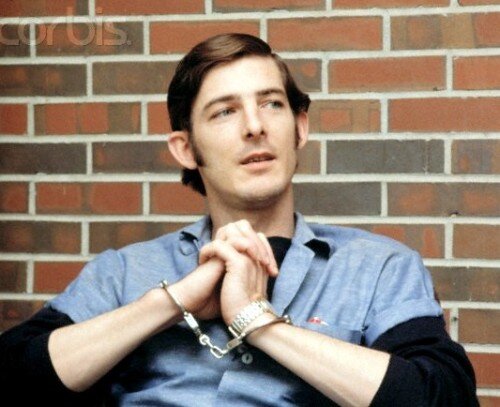The Last Supper: John Louis Evans
Not long after his release from an Indiana prison on parole John Louis Evans set out on a two-month crime spree that would involve more than thirty armed robberies, nine kidnappings and, ultimately, the murder of a pawn shop owner named Edward Nassar.
Evans was sentenced to death by electrocution for his crimes. “I have no malice for anyone, no hatred for anyone,” Evans told his executioner, smiling, as the black hood was placed over his face.
At 8:30 pm on April 22, 1983, the executioner threw the switch on the electric chair, sending some 1900 volts through Evans’ body. During the thirty second jolt Evans’ fists clenched, his body contorted and strained against the restraints. Sparks flew and grey smoke poured from under hood. The leather strap that secured his left leg burned through completely.
The doctor who examined Evans found a heart beat. His chest was heaving. Drool ran down from under the hood, pooling on his chest.
The executioner threw the switch a second time. This time flames erupted from under the hood. Witnesses described the scent of burning flesh as nauseating.
The doctor entered the execution chamber for a second time to examine Evans and, again, found a heartbeat.
At this point Evans’ attorney asked the governor to grant clemency on the grounds that Evans’ botched execution constituted cruel and unusual punishment. The request for clemency was denied.
At 8:40pm the executioner threw the switch for a third time. Evans was pronounced dead at 8:44pm, after 14 minutes of being burned alive.
John Louis Evans’ requested final meal was steak, shrimp, and french fries.
John Louis Evans (January 4, 1950 - April 22, 1983)
On Botched Electrocutions
Evans’ case is the second example of a botched execution to be featured in this project, following Clayton Lockett’s torturous 43 minute death by lethal injection. An estimated 3% of US executions (between 1890 and 2010) were botched in one way or another. An exhaustive discussion of the subject is obviously beyond the scope of this project — if you’re interested in that kind of thing Austin Sarat wrote an entire book on the subject titled Gruesome Spectacles: Botched Executions and America’s Death Penalty. There are many gristly stories contained within Sarat’s analysis and, in particular, a considerable number of botched electrocutions which echos Evans’ story. There’s William E. Vandiver’s 1985 execution, which took 17 minutes and 5 jolts of electricity. Witnesses described smoke and the smell of burning flesh during the procedure. In 1989 it took 19 minutes and two jolts of electricity to kill Horace Franklin Dunkins Jr. In 1990, during Jesse Joseph Tafero’s execution, three jolts of electricity were required and witnesses described seeing six inch flames surrounding Taferno’s head. During Pedro Medina’s 1997 electrocution foot-high flames erupted from the hood, filling the execution chamber with thick black smoke. The power was cut prematurely and Medina continued to breath for some time. Witnesses watched his chest heave until, eventually, both the man and the flames extinguished.
Inspiration and Composition
I draw considerable inspiration for my still life arrangement from the masters of the genre — mostly Dutch still life painters from the 17th century. The artist who has exerted the strongest sway over my creative output is almost certainly Pieter Claesz and, indeed, several of my photographs are composed in such a way as to pay homage to Claesz’ work. John Louis Evans’ final meal is loosely inspired by this 1633 painting of wine goblets, lemon, oysters, and bread:
As in Claesz’ work the rotting and seemingly abandoned food items serve as a reminder of transience and mortality. I borrowed from Claesz the trinity of drinking vessels that comprise the backbone of the piece: the upright jug on the left side of the image, the tipped wine goblet, and the overturned cup in the background. Taken together these evoke a sense of instability and are intended to represent the fragility of life. I also borrowed from Claesz the knife in the forground, whose handle dangles precariously over the edge of the table, reinforcing the underlying theme of instability and imbalance.


